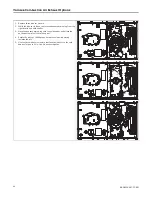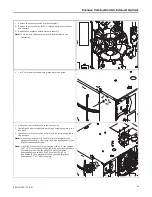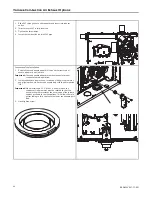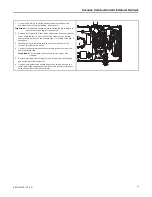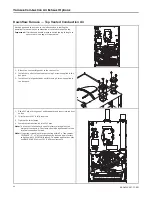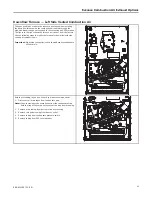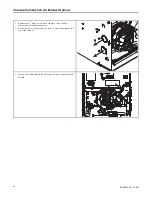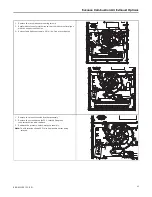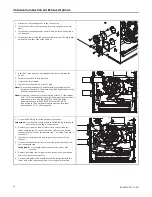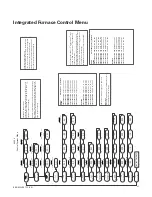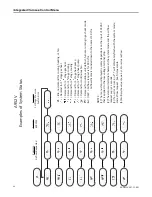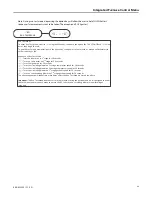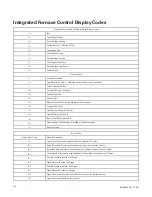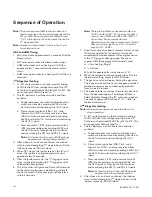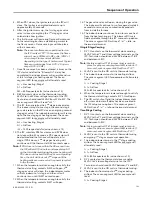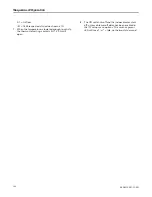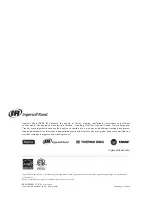
102
88-A952V001-1C-EN
Sequence of Operation
N
No
otte
e:: The seven segment LED readout is based on
thermostat input. During a simultaneous call for
W1 and W2, the seven segment LED will read
“
Xt2
”, although the IFC will process the call for
1
st
stage heat first.
N
No
otte
e:: Numbers in Parenthesis ( ) refer to the 12 pin
terminal positions.
E
EA
AC
C a
an
nd
d H
HU
UM
M T
Tiim
miin
ng
g
•
EAC relay closes approximately 2 seconds after the
blower starts.
•
EAC relay opens when the blower motor stops.
•
HUM relay closes on any heating call (HP/Gas)
approximately 1 second after the blower motor
starts.
•
HUM relay opens when any heating call (HP/Gas) is
removed.
1
1
sstt
S
Stta
ag
ge
e G
Ga
ass H
He
ea
attiin
ng
g
1. R – W1 contacts close on the thermostat sending
24VAC to the W1 low voltage terminal of the IFC.
Technician should read 24VAC from W1 to B/C. The
seven segment LED will read “
Xt1
”.
2. The IFC performs a self-check routine and then
confirms:
a. Condensate pressure switch and Inducer limit
switch are closed by sending 24VAC out the
HLO terminal and monitoring the ILI (1) input.
b. Flame roll-out switches (FRS) 1 & 2, main
thermal limit (TCO), and any reverse air flow
(RAF) switches are proved closed by sending
24VAC out the HLO (4) terminal and monitoring
the HLI (11) input.
c. Pressure switch 1 (PS1) and pressure switch 2
(PS2) are proved open by sending 24VAC out
the HLO terminal, through the limit switches,
and monitoring the PS1 (3) and PS2 (7) inputs.
N
No
otte
e:: If a thermal limit is open, 24VAC will not
be present at either pressure switch.
3. After steps a, b, and c are confirmed, the inducer
relay is closed energizing 1
st
stage inducer. As the
inducer ramps up, PS1 will close.
4. When PS1 closes, the ignitor relay on the IFC will
close. The ignitor is energized and warm up is
approximately 20 seconds.
5. After the ignitor warm up, the 1
st
stage gas valve
relay is closed, energizing the 1
st
stage gas valve
solenoid to allow ignition.
6. The first burner will ignite and flame will crossover
to the remaining burners, establishing current to
the flame sensor. Flame sensing must take place
within 4 seconds.
N
No
otte
e:: There are two flame sense pads located on
the IFC, marked “FP”. To measure the flame
current, use a VOM set to DC volts. 1VDC = 1
micro-amp. Flame current will vary
depending on the type of meter used. Typical
flame current ranges from 0.75 – 3.0 micro-
amps (0.75 – 3 VDC).
7. Once flame sense has been achieved, a timer on the
IFC starts and after the “Blower On” delay has
completed, the indoor blower will energize and run
at the 1
st
stage gas heating speed. The seven
segment LED for example will alternately read:
XtI
= Gas heating, Stage 1
ARF
= Airflow
060
= 600 requested cfm (value shown x 10)
8. When the temperature raises enough to satisfy the
thermostat setting, contacts R-W1 will open.
9. The gas valve relay will open, closing the gas valve.
The inducer will continue to run for approximately 5
seconds to remove any combustion byproducts
from inside the furnace.
10. The indoor blower continues to run to remove heat
from the heat exchangers. The blower off time is
field adjustable through the IFC menu setup option.
The seven segment LED will read “
IDL
” = Idle, no
thermostat demand.
2
2
n
nd
d
S
Stta
ag
ge
e G
Ga
ass H
He
ea
attiin
ng
g
N
No
otte
e:: 2
nd
stage heating cannot operate without 1
st
stage operation.
1. R – W1 contacts close on the thermostat sending
24VAC to the W1 low voltage terminal of the IFC.
Technician should read 24VAC from W1 to B/C. The
seven segment LED will read “
HT1
”
2. The IFC performs a self-check routine and then
confirms:
a. Condensate pressure switch and Inducer limit
switch are proved closed by sending 24VAC out
the HLO terminal and monitoring the ILI (1)
input.
b. Flame roll-out switches (FRS) 1 & 2, main
thermal limit (TCO), and any reverse air flow
(RAF) switches are closed by sending 24VAC out
the HLO (4) terminal and monitoring the HLI (11)
input.
c. Pressure switch 1 (PS1) and pressure switch 2
(PS2) are proved open by sending 24VAC out
the HLO terminal, through the limit switches,
and monitoring the PS1 (3) and PS2 (7) inputs.
N
No
otte
e:: If a thermal limit is open, 24VAC will not
be present at either pressure switch.
3. After steps a, b, and c are confirmed, the inducer
relay is closed energizing 1
st
stage inducer. As the
inducer ramps up, PS1 will close.

